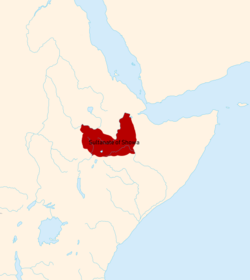Makhzumi dynasty | |||||||||||||
|---|---|---|---|---|---|---|---|---|---|---|---|---|---|
| 896–1286 | |||||||||||||
 The Sultanate of Shewa at its height under Sulṭān Malasmaʿī. | |||||||||||||
| Capital | Walalah (northern Hararghe)[1] | ||||||||||||
| Official languages | Arabic | ||||||||||||
| Common languages | Harla Argobba | ||||||||||||
| Religion | Sunni Islam | ||||||||||||
| Government | Absolute monarchy | ||||||||||||
| Sultan | |||||||||||||
• 896–928 (first) | Haboba | ||||||||||||
• 1279 (last) | ʿAbdallah | ||||||||||||
| History | |||||||||||||
• Established | 896 | ||||||||||||
| 1278–1285 | |||||||||||||
• Sultanate of Shewa annexed by Ifat | 1285 | ||||||||||||
• Disestablished | 1286 | ||||||||||||
| Currency | Dinar | ||||||||||||
| |||||||||||||
| Today part of | Ethiopia | ||||||||||||
The Makhzumi dynasty also known as Sultanate of Shewa or Shewa Sultanate, was a Muslim kingdom in present-day Ethiopia. Its capital Walale was situated in northern Hararghe in Harla country.[2][3][4] Its territory extended possibly to areas west of the Awash River.[5] The port of Zeila may have influenced the kingdom.[6] The rise of the Makhzumi state at the same time resulted in the decline of the Kingdom of Axum.[7] Several engravings dating back to the 13th century showing the presence of the kingdom are found in Chelenqo, Bale, Harla near Dire Dawa and Munesa near Lake Langano.[8]
It has recently been proposed that Shewa was not a unified Sultanate but rather a collection of smaller, autonomous political entities.[9]
- ^ Østebø, Terje (30 September 2011). Localising Salafism: Religious Change Among Oromo Muslims in Bale, Ethiopia. BRILL. p. 56. ISBN 978-9004184787.
- ^ Østebø, Terje (30 September 2011). Localising Salafism: Religious Change Among Oromo Muslims in Bale, Ethiopia. BRILL. p. 56. ISBN 978-9004184787.
- ^ The Ethno-History of Halaba People (PDF). p. 15. Archived from the original (PDF) on 5 July 2018. Retrieved 18 July 2017.
- ^ Braukhaper, Ulrich (2002). Islamic History and Culture in Southern Ethiopia: Collected Essays. LIT Verlag Münster. p. 21. ISBN 9783825856717. Retrieved 12 March 2017.
- ^ Braukhaper, Ulrich (2002). Islamic History and Culture in Southern Ethiopia: Collected Essays. LIT Verlag Münster. p. 21. ISBN 9783825856717. Retrieved 12 March 2017.
- ^ Hbrek, Ivan (1988). Africa from the Seventh to the Eleventh Century. UNESCO. p. 85. ISBN 9789231017094. Retrieved 10 January 2018.
- ^ "Ethiopianist Notes". African Studies Center, Michigan State University. 1–2: 17. 1977.
- ^ GIANFRANCESCO, LUSINI. LINGUE DI CRISTIANI E LINGUE DI MUSULMANI D'ETIOPIA. EDIZIONI DI STORIA E LETTERATURA. p. 136.
- ^ Chekroun, Amélie; Hirsch, Bertrand (2020). "The Sultanates of Medieval Ethiopia". A Companion to Medieval Ethiopia and Eritrea". Brill. p. 94.